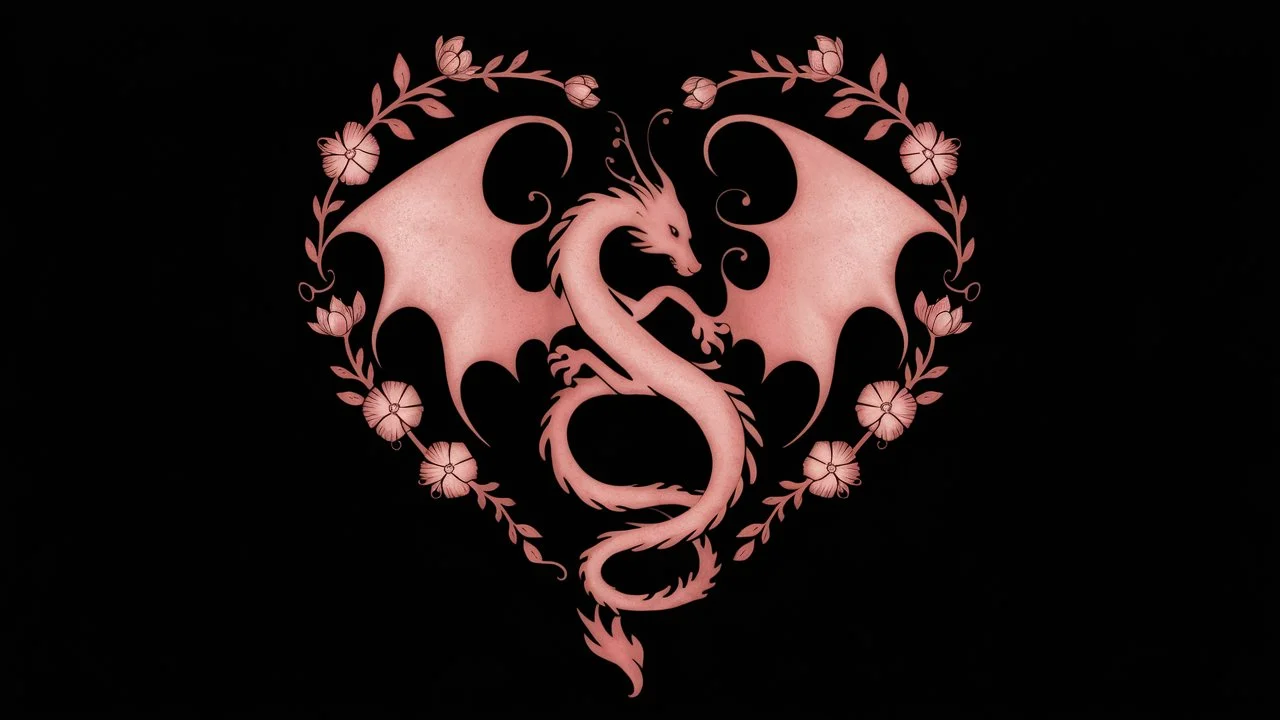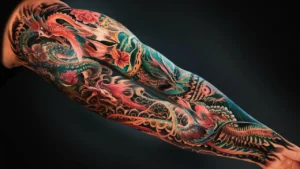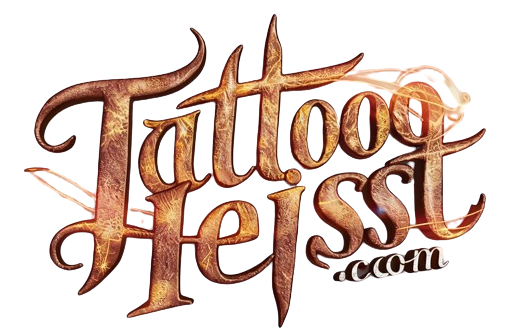Negative space tattoos are a unique and striking style of body art that utilizes the uninked areas of the skin to create powerful, visually engaging designs.
By playing with the contrast between inked and uninked areas, these tattoos highlight the art of minimalist design and can offer a refreshing take on traditional tattoo themes.
In this article, we’ll explore 30 creative negative space tattoo ideas, detailing their symbolism, design elements, and ideal placement on the body.
1. Geometric Animals
Geometric animals created with negative space use simple shapes and lines to form the outline of various creatures. This minimalist approach can include animals like wolves, lions, or birds, with their internal details left as negative space.
Meaning and Placement
Meaning: Represents the elegance of simplicity and the essence of the animal, focusing on clean, abstract forms.
Placement: Ideal for the forearm or upper arm, where the geometric shapes can be easily displayed and appreciated.
2. Minimalist Mountain Range
A minimalist mountain range tattoo uses negative space to outline the peaks and valleys, creating a clean and serene landscape. This design often features sharp, angular lines with vast stretches of uninked skin.
Meaning and Placement
Meaning: Symbolizes adventure, exploration, and the majesty of nature, focusing on the beauty of natural landscapes.
Placement: Best suited for the forearm, wrist, or along the side of the ribcage, where the mountain range can stretch out.
3. Silhouetted Animals
Silhouetted animals in negative space use the background of the tattooed area to form the shape of various animals. This design can include animals like deer, birds, or elephants, with intricate details left as negative space.
Meaning and Placement
Meaning: Represents the essence and natural beauty of animals, highlighting their form and presence through minimalist design.
Placement: Ideal for the upper arm or thigh, where the silhouette can be prominently featured.
4. Celestial Bodies
Celestial bodies like the moon, stars, and planets are depicted using negative space to create a dreamy and ethereal design. This style often features a dark background with the celestial elements left in stark contrast.
Meaning and Placement
Meaning: Symbolizes the vastness of the universe, mystery, and the wonder of the cosmos, creating a celestial theme.
Placement: Best suited for the forearm, upper arm, or back, where the celestial elements can be spread out.
5. Abstract Faces
Negative space tattoos of abstract faces use uninked areas to form expressive, minimalist portraits. These designs often feature simple lines and shapes that suggest facial features and expressions.
Meaning and Placement
Meaning: Represents emotions, identity, and the complexity of human expression through minimalist art.
Placement: Ideal for the upper arm, side, or forearm, where the abstract design can be displayed and appreciated.
6. Nature-Inspired Designs
Nature-inspired negative space tattoos use uninked areas to highlight natural elements like leaves, trees, or flowers. These designs often blend intricate details with clean, uninked spaces.
Meaning and Placement
Meaning: Symbolizes a connection to nature, growth, and the beauty of natural forms, emphasizing the elegance of simplicity.
Placement: Suitable for the forearm, upper arm, or thigh, where the natural elements can be showcased.
7. Geometric Shapes
Geometric shapes in negative space use the contrast between inked and uninked areas to create bold, abstract designs. These tattoos can feature triangles, circles, or polygons arranged in a visually striking manner.
Meaning and Placement
Meaning: Represents balance, order, and the beauty of abstract forms, focusing on clean lines and shapes.
Placement: Best suited for the forearm, wrist, or shoulder, where the geometric design can be clearly displayed.
8. Animal Tracks
Animal tracks created with negative space use uninked areas to form the shape of paws or hooves. This design can include tracks of various animals, symbolizing their presence and movement.
Meaning and Placement
Meaning: Symbolizes exploration, adventure, and a connection to wildlife, highlighting the essence of animal footprints.
Placement: Ideal for the ankle, forearm, or thigh, where the tracks can be displayed in a linear or scattered arrangement.
9. Compass Rose
A negative space compass rose uses the contrast between inked and uninked areas to form a classic navigational symbol. This design can be detailed with intricate lines and shapes, emphasizing the direction and adventure.
Meaning and Placement
Meaning: Represents guidance, direction, and the spirit of adventure, highlighting the importance of navigation and exploration.
Placement: Best suited for the upper arm, back, or chest, where the compass rose can be prominently displayed.
10. Silhouette of Hands
Silhouettes of hands in negative space use uninked areas to create dynamic and expressive hand gestures. This design can feature various poses, from holding objects to making intricate gestures.
Meaning and Placement
Meaning: Symbolizes communication, connection, and the power of gesture, focusing on the beauty of hand movements and expressions.
Placement: Ideal for the forearm or upper arm, where the hand silhouettes can be clearly depicted.
11. City Skylines
City skylines created with negative space use uninked areas to outline the contours of buildings and landmarks. This design often features a minimalist representation of a cityscape, emphasizing the urban environment.
Meaning and Placement
Meaning: Represents the vibrancy and energy of city life, capturing the essence of urban landscapes through minimalist design.
Placement: Best suited for the forearm, upper arm, or back, where the city skyline can be displayed in its entirety.
12. Origami Animals
Origami animals in negative space use uninked areas to form the shapes of various folded paper creatures. This design often features clean lines and angular shapes, mimicking the art of origami.
Meaning and Placement
Meaning: Symbolizes creativity, transformation, and the art of simplicity, reflecting the delicate nature of origami.
Placement: Ideal for the forearm or upper arm, where the origami animals can be showcased.
13. Optical Illusions
Negative space tattoos that create optical illusions use the contrast between inked and uninked areas to form designs that appear to shift or change when viewed from different angles. This style plays with visual perception and depth.
Meaning and Placement
Meaning: Represents the playfulness of perception and the complexity of visual art, creating a design that captivates and engages viewers.
Placement: Best suited for the forearm, upper arm, or back, where the illusion can be fully appreciated.
14. Symbolic Shapes
Symbolic shapes like crosses, anchors, or hearts can be rendered in negative space to create minimalist, yet meaningful designs. These tattoos often feature simple outlines with the symbol left as negative space.
Meaning and Placement
Meaning: Represents the essence of the chosen symbol, focusing on its core meaning and significance through minimalist design.
Placement: Ideal for the wrist, forearm, or upper arm, where the symbolic shape can be prominently displayed.
15. Nature Silhouettes
Silhouettes of natural elements like trees, mountains, or waves in negative space use uninked areas to highlight the beauty of these forms. This design often features simple outlines and clean lines.
Meaning and Placement
Meaning: Symbolizes a connection to nature and the beauty of natural forms, creating a design that emphasizes simplicity and elegance.
Placement: Best suited for the forearm, upper arm, or back, where the natural silhouettes can be showcased.
16. Animal Eyes
Animal eyes created with negative space use uninked areas to form the striking gaze of various creatures. This design often features detailed eyes with the rest of the animal’s form left as negative space.
Meaning and Placement
Meaning: Represents the intensity and focus of the animal’s gaze, highlighting the power and depth of their vision.
Placement: Ideal for the upper arm, forearm, or thigh, where the eyes can be displayed in detail.
17. Abstract Waves
Abstract waves in negative space use uninked areas to create fluid, flowing designs that evoke the movement of water. This design can feature sweeping lines and curves, emphasizing the dynamic nature of waves.
Meaning and Placement
Meaning: Symbolizes the fluidity and movement of water, capturing the elegance and power of natural forces.
Placement: Best suited for the forearm, side, or back, where the waves can flow naturally along the body’s contours.
18. Birds in Flight
Negative space tattoos of birds in flight use the contrast between inked and uninked areas to form the shape of soaring birds. This design often features dynamic wing shapes and graceful flight patterns.
Meaning and Placement
Meaning: Represents freedom, grace, and the beauty of flight, emphasizing the elegance of birds in motion.
Placement: Ideal for the upper arm, back, or chest, where the birds’ flight can be fully displayed.
19. Music Notes
Music notes in negative space use uninked areas to create minimalist representations of musical symbols. This design often features clean lines and simple shapes, highlighting the essence of music.
Meaning and Placement
Meaning: Symbolizes a love for music and the art of sound, focusing on the beauty and simplicity of musical notation.
Placement: Best suited for the wrist, forearm, or side, where the music notes can be displayed prominently.
20. Feathers
Feathers in negative space use uninked areas to create elegant and detailed designs of various bird feathers. This design often features intricate lines and delicate patterns, emphasizing the lightness of feathers.
Meaning and Placement
Meaning: Represents freedom, lightness, and the beauty of nature, capturing the delicate nature of feathers.
Placement: Ideal for the forearm, upper arm, or back, where the feathers can be showcased in detail.
21. Compass and Map
A negative space tattoo featuring a compass and map uses uninked areas to form navigational elements. This design often includes a compass rose and a minimalist map outline, emphasizing adventure and exploration.
Meaning and Placement
Meaning: Represents guidance, direction, and the spirit of exploration, capturing the essence of navigation and travel.
Placement: Best suited for the upper arm, back, or chest, where the compass and map can be prominently displayed.
22. Moon Phases
Moon phases in negative space use uninked areas to create a minimalist representation of the lunar cycle. This design often features simple crescent, half, and full moon shapes, highlighting the phases of the moon.
Meaning and Placement
Meaning: Symbolizes change, cycles, and the connection to the lunar calendar, focusing on the beauty of the moon’s phases.
Placement: Ideal for the forearm, upper arm, or side, where the moon phases can be displayed in a linear arrangement.
23. Silhouetted Landscapes
Silhouetted landscapes use negative space to outline various natural scenes like forests, mountains, or lakes. This design often features detailed outlines of the landscape with the background left uninked.
Meaning and Placement
Meaning: Represents the beauty and serenity of natural landscapes, capturing the essence of outdoor scenes through minimalist design.
Placement: Best suited for the forearm, upper arm, or back, where the landscape can be spread out.
24. Constellations
Constellations in negative space use uninked areas to form the shapes of stars and their connections. This design often features simple lines and dots, creating a minimalist representation of celestial patterns.
Meaning and Placement
Meaning: Symbolizes guidance, destiny, and the connection to the stars, emphasizing the beauty of celestial navigation.
Placement: Ideal for the forearm, upper arm, or back, where the constellations can be displayed in detail.
25. Animal Silhouettes
Animal silhouettes in negative space use uninked areas to form the shapes of various animals. This design often features simple outlines with the animal’s form left as negative space.
Meaning and Placement
Meaning: Represents the essence of the chosen animal, focusing on its form and presence through minimalist design.
Placement: Best suited for the upper arm, thigh, or back, where the animal silhouette can be showcased.
26. Abstract Lines
Abstract lines in negative space use uninked areas to create dynamic and fluid designs. This design often features intersecting lines and shapes that form an abstract composition.
Meaning and Placement
Meaning: Symbolizes creativity, movement, and the beauty of abstract art, capturing the essence of line-based designs.
Placement: Ideal for the forearm, side, or back, where the abstract lines can be displayed prominently.
27. Portrait Silhouettes
Portrait silhouettes in negative space use uninked areas to create minimalist representations of faces or figures. This design often features simple outlines of facial features and profiles.
Meaning and Placement
Meaning: Represents identity, expression, and the essence of the human form, focusing on minimalist portraiture.
Placement: Best suited for the upper arm, side, or forearm, where the portrait silhouette can be clearly displayed.
28. Heartbeat Line
A heartbeat line in negative space uses uninked areas to form the shape of an EKG or heart monitor reading. This design often features a clean, continuous line that represents the rhythm of life.
Meaning and Placement
Meaning: Symbolizes life, vitality, and the rhythm of the heart, capturing the essence of health and emotion.
Placement: Ideal for the wrist, forearm, or chest, where the heartbeat line can be prominently displayed.
29. Mountain Silhouettes
Mountain silhouettes in negative space use uninked areas to create minimalist representations of mountain ranges. This design often features clean, angular lines that outline the peaks and valleys.
Meaning and Placement
Meaning: Represents adventure, resilience, and the majesty of nature, capturing the essence of mountainous landscapes.
Placement: Best suited for the forearm, upper arm, or back, where the mountain silhouettes can be showcased.
30. Star Map
A star map in negative space uses uninked areas to form the shapes of stars and constellations. This design often features a minimalist representation of a night sky, highlighting the beauty of celestial navigation.
Meaning and Placement
Meaning: Symbolizes guidance, destiny, and the connection to the cosmos, capturing the essence of the night sky through minimalist design.
Placement: Ideal for the forearm, upper arm, or back, where the star map can be displayed in detail.
Conclusion: Choosing the Perfect Negative Space Tattoo
Selecting the right negative space tattoo involves considering the design’s symbolism, style, and placement. Negative space tattoos offer a unique and artistic approach to body art, focusing on the contrast between inked and uninked areas. To choose the perfect tattoo, consider the following tips:
- Personal Connection: Choose a design that resonates with your personal experiences or interests, ensuring it holds deep meaning.
- Symbolism: Think about the meanings behind the design elements and how they reflect your values or personality.
- Style: Decide whether you prefer a minimalist design or something more complex, and choose a tattoo that aligns with your aesthetic preferences.
- Placement: Consider how the tattoo will flow with your body’s contours and how it will be displayed in various positions.
- Artist’s Expertise: Select a tattoo artist experienced in negative space designs to ensure the intricate details and contrast are accurately represented.
By carefully considering these factors, you can choose a negative space tattoo that not only looks stunning but also holds deep personal significance.

I’m Justin Taylor, the force behind Tattoo Heist. With a profound passion for ink and a wealth of experience in the tattoo industry, I showcase exceptional tattoo artistry, share expert tips, and delve into the stories behind each design.






